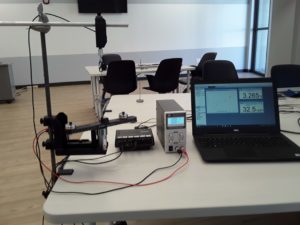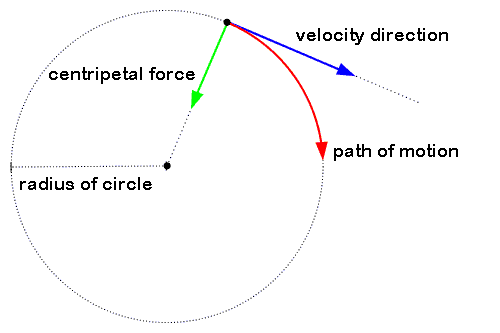Centripetal Acceleration
Objectives
- Measure the trend in the force exerted by a string on a mass in circular motion when the angular velocity is varied as the radius is held constant and compare to the predicted trend.
- Measure the trend in the force exerted by a string on a mass in circular motion when the radius is varied while the angular velocity is held constant and compare to the predicted trend.
Resources
- Centripetal Motion Apparatus
- Force sensor and photogate (for detecting rotations/sec)
- Lab power supply
- Circular masses
- Science Workshop interface and DataStudio software
- DataStudio setup file CentripetalMotion.ds
Background
An object in uniform circular motion must have a net force acting toward the center of rotation with magnitude F_{net}=m\frac{v^2}{r} =m\omega^2 r
Setup
The apparatus you will use in this lab consists of a rotating, motorized arm to which weights can be attached. There is a weight holder at each end of the arm. One of the weight holders is fixed. The other slides freely along a groove in the rotating arm and is attached to a force sensor with a steel wire that runs over a pulley at the axis of the rotating arm. By attaching weights to the sliding mass holder, the centripetal acceleration provided by the tension in the steel wire when the arms rotate can be measured by the force sensor. A small flag underneath the arm passes through a photogate each rotation. Since each rotation is 360°, or 2π radians, the time between each photogate triggering gives the angular velocity of the arms.
The fixed mass holder is provided as a counterbalance to prevent the apparatus from wobbling out of control at high speeds. It is a good idea to have equal amounts of mass on each end of the arm. The fixed mass holder itself has a mass of 2.5 grams, and the sliding mass holder has a mass of 4.0 grams. The apparatus has the potential to spin very rapidly and cause injury. Before turning on the power supply for the first time, turn the voltage and current all the way down. Then, turn on the power supply, turn the current knob to 10-20%, and slowly increase the voltage to get a feel for the speed of the rotating arms. Attach weights securely when using the apparatus.
Analysis Questions
- When keeping the radius constant while varying the angular velocity, what should the slope of a force vs. squared angular velocity graph be equal to? Calculate this value and compare to your data.
- Calculate what the slope of force vs. radius should be if you keep the angular velocity of the spinning mass constant while varying the radius. Compare to your data and explain the results.
